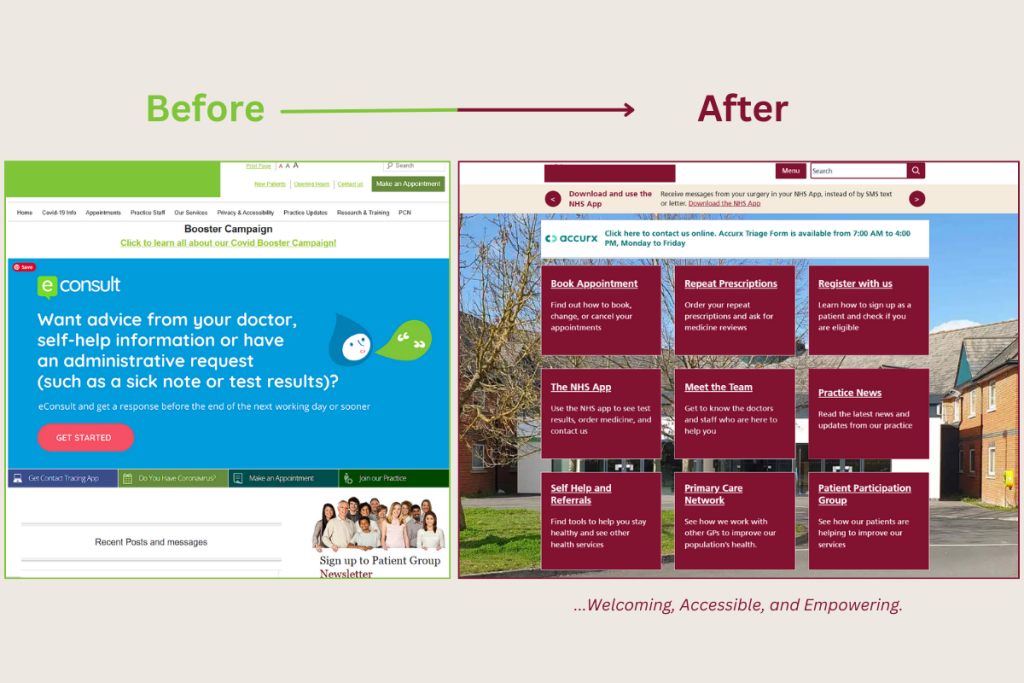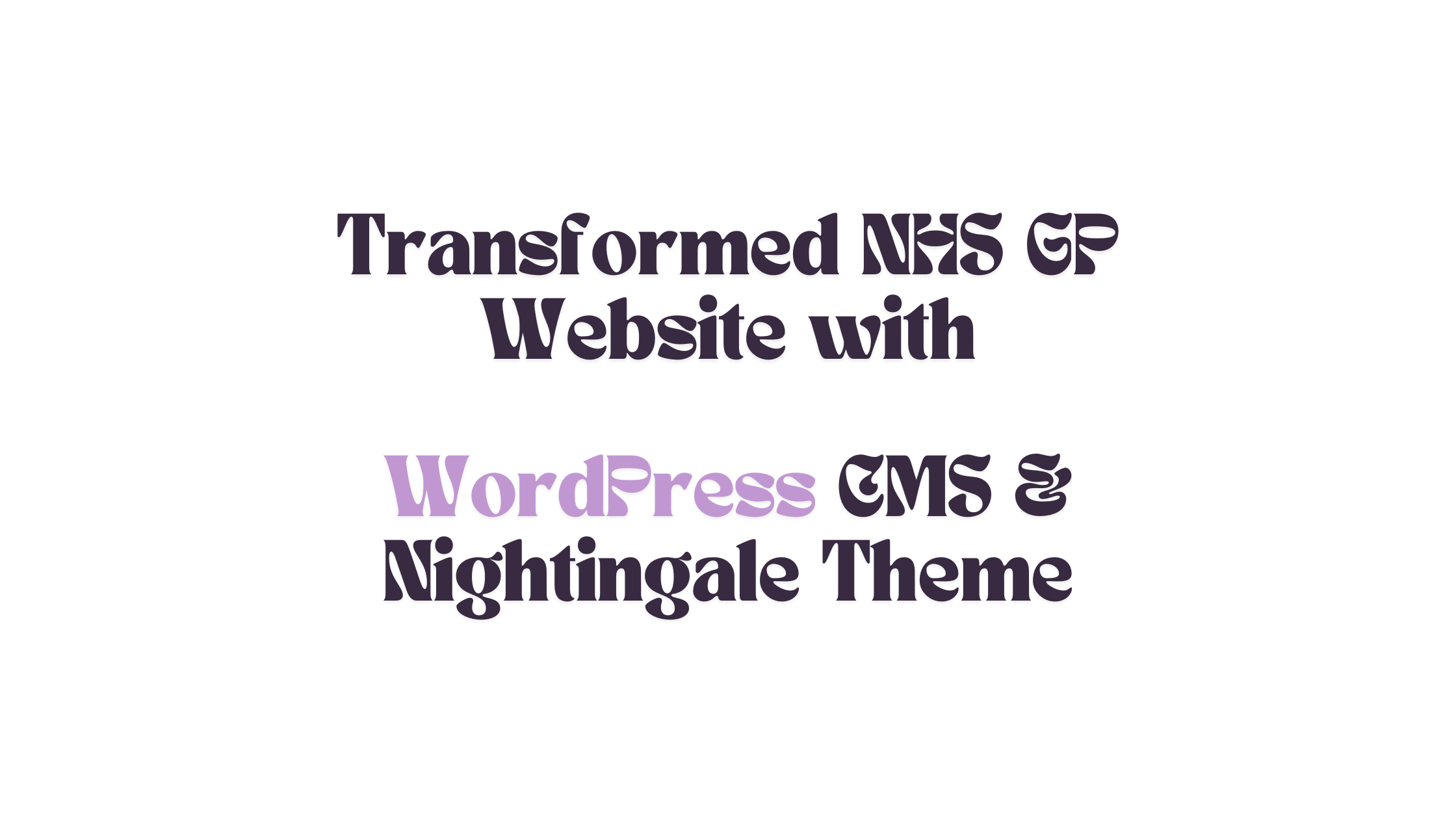In May 2023, NHSE released a GP website benchmarking and improvement tool.
The tool has three focuses but the top two are:
- The top tasks that patients want to do on a GP website
- The things that patients found most challenging on GP websites
At our PCN, we used this tool to benchmark our GP websites, improve them, and create an adjusted benchmarking framework that meets all NHS guidelines.
How do our GP websites meet the top tasks that patients want to do on a GP website?
There are four key patient priorities when they visit a GP website:
- Book appointments,
- Repeat prescription information,
- Get test results,
- Find opening hours and contact information
Recent GP website design adopted square boxes for each item.
We followed this best practice; the first two boxes are book appointments and repeat prescription information.
Grouped the test results and repeat prescriptions under the NHS App box.
As the NHS App has become a preferred way of managing test result requests
Information on opening hours and contact-us were grouped as top items on the website menu.

We use a homepage pop-up, but how does it help patients use the website?
The NHS GP website benchmarking tool identified overlays and pop-ups as the most inconvenient features of many GP websites.
However, while collaborating with the management team and drawing significant input from the Patient and Care Co-ordinator Teams (PCT),
we agreed that a pop-up was necessary to improve patient access to the appointment booking link.
Although time constraints prevented me from conducting A/B tests on all the website buttons to analyze user behavior and peak interaction times,
data from the PCT indicated that most patients were primarily seeking the appointment booking link.
As a result, we implemented a well-designed pop-up as an effective solution to enhance patient engagement on the website.
Why Pop-ups Could Be a Good Addition to GP Websites
Most GP websites that collect data to understand user interactions already use cookie consent pop-ups.
The key advantage is that these pop-ups are carefully designed to load seamlessly with the website,
rather than appearing afterward. This reduces the element of surprise for visitors, who might otherwise associate pop-ups with intrusive, ad-heavy websites—an issue that can negatively impact usability.
Similarly, transactional pop-ups can be implemented in the same user-friendly way.
These pop-ups remain a highly effective and personal tool for guiding users to essential features and encouraging them to make the most of the website.
When well-designed, a pop-up that serves its purpose and directs users to the right place can significantly enhance the user experience, making it a valuable addition to GP websites.
Why Did We Revamp the Website?
The previous website was difficult to navigate.
While it had a functional translation button, the large homepage slider occupied excessive space, and the overuse of multiple colours failed to create a caring atmosphere for patients visiting the site.
Much of the information was outdated, including COVID-19 guidelines from years ago, which were irrelevant by 2024.
Additionally, patient feedback survey links were broken, and redundant links cluttered the site, leading to the same pages repeatedly.
There was also a lack of guidance on how to use the website effectively, and the copyright information was stuck in 2017, indicating the functionality wasn’t coded to update dynamically with the year.
Ultimately, the website did not reflect the excellent work of the team, which had earned the GP its current Good CQC rating.
A revamp was necessary to align the website’s functionality and aesthetics with the quality of care provided.
Why Website Suppliers Alone Are Not the Answer to a Compliant GP Surgery Website
Delivering a website that requires regular updates demands more than just outsourcing to website suppliers—it requires ongoing technical skills and attention to detail to maintain usability and compliance.
One critical aspect is the ability to clearly define areas for static and dynamic content.
For example, the homepage notice displaying prescription opening times is frequently updated and must remain accurate to serve patients effectively.
To address this need, I created a custom post type called “homepage notice.”
This feature allows quick updates with minimal effort while limiting the displayed content to three items to keep the section focused and relevant.
This level of customization ensures the website remains compliant, user-friendly,
and reflective of the high standards of care provided by the surgery—something website suppliers alone cannot consistently deliver without in-house oversight and technical expertise.

And the admins were adequately trained to make use of that feature.
It would be difficult to break things with the way it is being updated.
The reality is that website suppliers alone won’t solve the problem of inaccessible GP websites. While there are excellent suppliers out there
Any supplier could do a similar thing, but that personable approach working with non-technical staff to get the requirement.
That results in usable websites as this needs more agency engagement with the surgery.
Which, in a way, can also increase the cost of the website package
The Role of Digital Transformation Leads (DTLs) in Enhancing GP Websites Through User Insights
The surgery is always busy, with a constant need to deliver safe care to patients.
While GP partners and practice management dedicate limited hours to service improvement, their focus is primarily on clinical pathways.
Digital tools, which play a crucial role, are often outsourced.
One solution is to have technically skilled individuals serve as Data and Digital Leads or Digital Transformation Leads,
especially for large PCNs, granting them access to GP surgery websites and other digital systems.
For example, a website requires:
- A domain name (e.g., the practice name).
- Hosting (where files are stored, like common data).
- A platform (content management system, like EMIS).
- A theme (the look and feel, e.g., an Arden’s template).
- Content (the actual information).
A VPS Linux Hosting Account with unlimited traffic of up to 1 Gbit/s from IONOS
and 16 GB RAM in a UK data centre costs £28/month and can host up to 50 GP WordPress websites.
An average GP website costs £800 per year, while with the same amount you can set up a multi-wordpress site for all GP surgery in a PCN including the domain names.
With this setup individual practices can still have access to their unique website login.
While also benefiting from centralised website content updates.
Why WordPress is the Most Suited for GP & PCN Websites
When it comes to IT solutions, numbers matter.
WordPress powers 43% of all websites globally with a large amount of developers contributing to the platform.
This means you can easily find WordPress talent than you would ASP.net
Some suppliers use the Nightingale theme build by NHS Leadership Academy Digital Team
you can use the same.
It makes it easier to deploy an NHS compliant website in minutes
Learn WordPress in 13 Minutes
Whether you are a DTL or a practice data/digital lead,
you can learn WordPress basics using their study hours or Protected Learning Time (PLT).
You don’t need to write a single line of code to start.
With WordPress, the possibilities are endless,
and its flexibility can unlock simplified ways to keep your practice website always relevant and updated.
